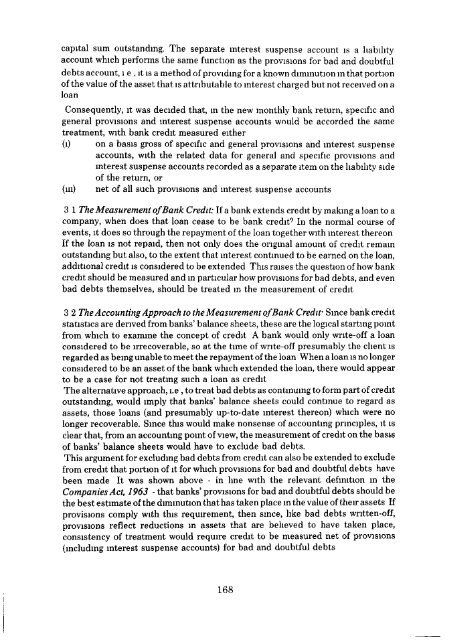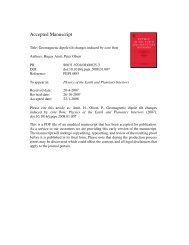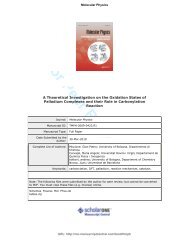parti: objectives and features of the new reporting system 159 - TARA
parti: objectives and features of the new reporting system 159 - TARA
parti: objectives and features of the new reporting system 159 - TARA
Create successful ePaper yourself
Turn your PDF publications into a flip-book with our unique Google optimized e-Paper software.
capital sum outst<strong>and</strong>ing. The separate interest suspense account is a liability<br />
account which performs <strong>the</strong> same function as <strong>the</strong> provisions for bad <strong>and</strong> doubtful<br />
debts account, 1 e , it is a method <strong>of</strong> providing for a known diminution in that portion<br />
<strong>of</strong> <strong>the</strong> value <strong>of</strong> <strong>the</strong> asset that is attributable to interest charged but not received on a<br />
loan<br />
Consequently, it was decided that, in <strong>the</strong> <strong>new</strong> monthly bank return, specific <strong>and</strong><br />
general provisions <strong>and</strong> interest suspense accounts would be accorded <strong>the</strong> same<br />
treatment, with bank credit measured ei<strong>the</strong>r<br />
(1) on a basis gross <strong>of</strong> specific <strong>and</strong> general provisions <strong>and</strong> interest suspense<br />
accounts, with <strong>the</strong> related data for general <strong>and</strong> specific provisions <strong>and</strong><br />
interest suspense accounts recorded as a separate item on <strong>the</strong> liability side<br />
<strong>of</strong> <strong>the</strong> return, or<br />
(m) net <strong>of</strong> all such provisions <strong>and</strong> interest suspense accounts<br />
3 1 The Measurement <strong>of</strong> Bank Credit: If a bank extends credit by making a loan to a<br />
company, when does that loan cease to be bank credit 9 In <strong>the</strong> normal course <strong>of</strong><br />
events, it does so through <strong>the</strong> repayment <strong>of</strong> <strong>the</strong> loan toge<strong>the</strong>r with interest <strong>the</strong>reon<br />
If <strong>the</strong> loan is not repaid, <strong>the</strong>n not only does <strong>the</strong> original amount <strong>of</strong> credit remain<br />
outst<strong>and</strong>ing but also, to <strong>the</strong> extent that interest continued to be earned on <strong>the</strong> loan,<br />
additional credit is considered to be extended This raises <strong>the</strong> question <strong>of</strong> how bank<br />
credit should be measured <strong>and</strong> in <strong>parti</strong>cular how provisions for bad debts, <strong>and</strong> even<br />
bad debts <strong>the</strong>mselves, should be treated in <strong>the</strong> measurement <strong>of</strong> credit<br />
3 2 The Accounting Approach to <strong>the</strong> Measurement <strong>of</strong> Bank Credit' Since bank credit<br />
statistics are derived from banks' balance sheets, <strong>the</strong>se are <strong>the</strong> logical starting point<br />
from which to examine <strong>the</strong> concept <strong>of</strong> credit A bank would only write-<strong>of</strong>f a loan<br />
considered to be irrecoverable, so at <strong>the</strong> time <strong>of</strong> write-<strong>of</strong>f presumably <strong>the</strong> client is<br />
regarded as being unable to meet <strong>the</strong> repayment <strong>of</strong> <strong>the</strong> loan When a loan is no longer<br />
considered to be an asset <strong>of</strong> <strong>the</strong> bank which extended <strong>the</strong> loan, <strong>the</strong>re would appear<br />
to be a case for not treating such a loan as credit<br />
The alternative approach, i.e , to treat bad debts as continuing to form part <strong>of</strong> credit<br />
outst<strong>and</strong>ing, would imply that banks' balance sheets could continue to regard as<br />
assets, those loans (<strong>and</strong> presumably up-to-date interest <strong>the</strong>reon) which were no<br />
longer recoverable. Since this would make nonsense <strong>of</strong> accounting principles, it is<br />
clear that, from an accounting point <strong>of</strong> view, <strong>the</strong> measurement <strong>of</strong> credit on <strong>the</strong> basis<br />
<strong>of</strong> banks' balance sheets would have to exclude bad debts.<br />
This argument for excluding bad debts from credit can also be extended to exclude<br />
from credit that portion <strong>of</strong> it for which provisions for bad <strong>and</strong> doubtful debts have<br />
been made It was shown above - in line with <strong>the</strong> relevant definition m <strong>the</strong><br />
Companies Act, 1963 - that banks' provisions for bad <strong>and</strong> doubtful debts should be<br />
<strong>the</strong> best estimate <strong>of</strong> <strong>the</strong> diminution that has taken place in <strong>the</strong> value <strong>of</strong> <strong>the</strong>ir assets If<br />
provisions comply with this requirement, <strong>the</strong>n since, like bad debts wntten-<strong>of</strong>f,<br />
provisions reflect reductions in assets that are believed to have taken place,<br />
consistency <strong>of</strong> treatment would require credit to be measured net <strong>of</strong> provisions<br />
(including interest suspense accounts) for bad <strong>and</strong> doubtful debts<br />
168
















